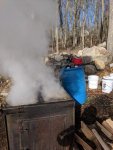Hello All,
I am new to this and just installed my 30' above ground with some family help. We live in rural Tennessee and are looking for a way to extend our swimming season. I have done some research on rocket stoves and furnaces and was wondering if anyone was utilizing this technique in pool heating. There seems to be some merit if you are out in the sticks and have plenty of them. They are effecient and do not create smoke if done right. I know the key to heating efficientcy is high flow heated a few degrees. Similar to Sous Vi cooking. Not looking to heat all year just extend our pool time where we can using resources we have. Any ideas or direction greatly appreciated.
I am new to this and just installed my 30' above ground with some family help. We live in rural Tennessee and are looking for a way to extend our swimming season. I have done some research on rocket stoves and furnaces and was wondering if anyone was utilizing this technique in pool heating. There seems to be some merit if you are out in the sticks and have plenty of them. They are effecient and do not create smoke if done right. I know the key to heating efficientcy is high flow heated a few degrees. Similar to Sous Vi cooking. Not looking to heat all year just extend our pool time where we can using resources we have. Any ideas or direction greatly appreciated.


